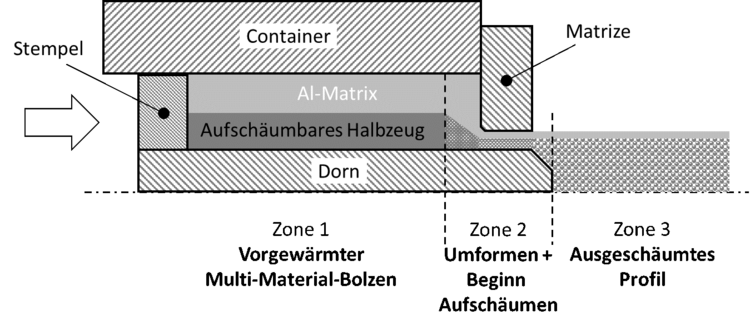Aluminiumlegierungen mit angepasstem Schmelzintervall für das prozessintegrierte Ausschäumen beim Strangpressen

| Year: | 2017 |
| Date: | 31-05-20 |
| Funding: | DFG |
| Duration: | 05/2017-01/2021 |
| Is Finished: | yes |
Foam-filled extruded profiles offer an excellent combination of low density and good mechanical properties. However, the downside of these products is that either foamed inlays need to be inserted into and then glued to the extruded profiles, or foamable precursors are inserted into the profiles and foamed in a separate heat treatment step. Alternatively, a foamable precursor and a structural material can be co-extruded together and then foamed in a separate heat treatment step. However, these production processes require additional handling and heat treatment steps. The aim of the proposed research project is the development of fundamental knowledge for the direct foam-filling of extruded hollow profiles using the process heat generated during extrusion. In the first step, foamable precursors will be studied. These precursors will be based on low melting aluminium hard solders. Their melting range needs to be adjusted to the forming temperature of the structural material, which in this case will be the aluminium wrought alloy EN AW 6082. The most important point to be considered for the development of the aluminium hard solders is the onset of the foaming phase, as this has to be simultaneously occurring while the material enters the forming zone or when exiting the die. Promising alloys will then be investigated based on their foaming behaviour determined in free foaming tests. This will include addition of stabilising alloying elements and foaming agents, adapted for processing in extrusion. An additional change of the processing route for the foamable precursor, a second extrusion process, is envisaged to, firstly, further improve the foaming behaviour and secondly, to improve the material usage during processing. Subsequent co-extrusion trials, using a special extrusion die allowing for an improved control of the process conditions, will allow for obtaining a process window for the foaming phase during extrusion. Finally, a prototype of an extruded and foam-filled tube will be tested to evaluate the microstructural and mechanical properties by both non-destructive and destructive testing methods.




















